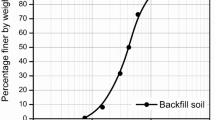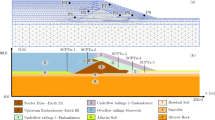Abstract
Many of the world’s concrete dams are approaching the end of their expected service life and many of these dams are cracked due to environmental effects. It is thus desirable to be able to extend the service life of many of these dams. It is therefore important to develop reliable methods of analysis to assess the current status of these dams and to determine the safety of these, partly damaged structures. A slender reinforced concrete arch dam is used as a case study with the aim of predicting the structural response, the cracks found in-situ and of assessing the safety of the dam. This dam has cracked extensively along the downstream face primarily due to seasonal temperature variations. A detailed finite element model has been developed to simulate the history of the dam with the variations in ambient conditions that have occurred over its lifetime. The results show good agreement regarding both the crack pattern and displacement of the dam. A procedure to simulate a progressive dam failure, starting from the current state, is utilized to assess the current level of safety. The results show that the cracking has a limited effect on the safety factor of the dam.
Similar content being viewed by others
References
Andersson O, Seppälä M (2015) Verification of the response of a concrete arch dam subjected to seasonal temperature variations. MSc Thesis, KTH Royal Institute of Technology, Stockholm, Sweden
Bäck J, Nobile F, Tamellini L, Tempone R (2011) Stochastic spectral galerkin and collocation methods for PDEs with random coefficients: A numerical comparison. In: Spectral and high order methods for partial differential equations, Berlin, Heidelberg. Springer, Berlin, Heidelberg, Germany
Bazant ZP (1986) Mechanics of distributed cracking. Applied Mechanics Reviews 39(5):675–705, DOI: https://doi.org/10.1115/1.3143724
Bonizzoni F, Nobile F, Kressner D (2016) Tensor train approximation of moment equations for elliptic equations with lognormal coefficient. Computer Methods in Applied Mechanics and Engineering 308: 349–376, DOI: https://doi.org/10.1016/j.cma.2016.05.026
Brühwiler E (1990) Fracture of mass concrete under simulated seismic action. Dam Engineering 1(3):153–176
Duffaut P (2013) The traps behind the failure of Malpasset arch dam, France, in 1959. Journal of Rock Mechanics and Geotechnical Engineering 5(5):335–341, DOI: https://doi.org/10.1016/j.jrmge.2013.07.004
Enzell J, Tollsten M (2017) Thermal cracking of a concrete arch dam due to seasonal temperature variations. MSc Thesis, KTH Royal Institute of Technology, Stockholm, Sweden
Eurocode 2 (2013) Design of concrete structures. Part 1–1: General rules and rules for buildings. SS-EN 1992-1-1:2005, Swedish Standards Institute (SIS)
FERC (1999) Engineering guidelines for the evaluation of hydropower projects, Chapter 11 — Arch dams. Federal Energy Regulatory Commission, Division of Dam Safety and Inspections, Washington DC, USA
FERC (2016) Engineering guidelines for the evaluation of hydropower projects, Chapter 3 — Gravity dams. Federal Energy Regulatory Commission, Division of Dam Safety and Inspections, Washington DC, USA
FERC (2018) Engineering guidelines for the evaluation of hydropower projects, Chapter 11 — Arch dams. Federal Energy Regulatory Commission, Division of Dam Safety and Inspections, Washington DC, USA
FIB (2010) fib model code for concrete structures 2010. International Federation for Structural Concrete (fib), Lausanne, Switzerland
Fu C, Hafliðason B (2015) Progressive failure analyses of concrete buttress dams: Influence of crack propagation on the structural dam safety. MSc Thesis, KTH Royal Institute of Technology, Stockholm, Sweden
Fumagalli E (1973) Statical and geomechanical models. Springer, New York, NY, USA
Ghaemmaghami A, Ghaemian M (2006) Large-scale testing on specific fracture energy determination of dam concrete. International Journal of Fracture 141(1):247–254, DOI: https://doi.org/10.1007/s10704-006-0078-3
Hariri-Ardebili MA, Salamon J, Mazza G, Tosun H, Xu B (2020) Advances in dam engineering. Infrastructures 5(5):39, DOI: https://doi.org/10.3390/infrastructures5050039
Hellgren R (2019) Condition assessment of concrete dams in cold climate. Licentiate Dissertation, KTH Royal Institute of Technology, Stockholm, Sweden
Hellgren R, Malm R (2017) Stability assessment of concrete dams with non-linear FEA. Proceedings of the XXIII Nordic concrete research symposium, August 21–23, Aalborg, Denmark
Hofstetter B, Valentini G (2013) Review and enhancement of 3D concrete models for large-scale numerical simulations of concrete structures. International Journal for Numerical and Analytical Methods in Geomechanics 37(3):221–246, DOI: https://doi.org/10.1002/nag.1096
Lee J, Fenves GL (1998) Plastic-damage model for cyclic loading of concrete structures. Journal of Engineering Mechanics 124(8):892–900, DOI: https://doi.org/10.1061/(ASCE)0733-9399(1998)124:8(892)
Léger P, Leclerc M (2007) Hydrostatic, temperature, time-displacement model for concrete dams. Journal of Engineering Mechanics 133(3): 267–277, DOI: https://doi.org/10.1061/(ASCE)0733-9399(2007)133:3(267)
Lubliner J, Oliver J, Oller S, Oñate E (1989) A plastic-damage model for concrete. International Journal of Solids and Structures 25(3): 299–326, DOI: https://doi.org/10.1016/0020-7683(89)90050-4
Maken D, Léger P, Roth S-N (2013) Seasonal thermal cracking of concrete dams in northern regions. Journal of Performance of Constructed Facilities 28(4):04014014, DOI: https://doi.org/10.1061/(ASCE)CF.1943-5509.0000483
Malm R (2009) Predicting shear type crack initiation and growth in concrete with non-linear finite element method. PhD Thesis, KTH Royal Institute of Technology, Stockholm, Sweden
Malm R (2016) Guideline for FE analyses of concrete dams. Energiforsk Report 2016:270, Stockholm, Sweden
Malm R, Ansell A (2011) Cracking of concrete buttress dam due to seasonal temperature variation. ACI Structural Journal 108(1):13–22
Malm R, Hellgren R, Ekström T, Fu C (2017) Description and synthesis of theme A — Thermal cracking of a concrete arch dam. In: Proceedings of the 14th ICOLD international benchmark workshop on numerical analysis of dams, September 6–8, Stockholm, Sweden
Malm R, Hellgren R, Enzell J (2020) Lessons learned regarding cracking of a concrete arch dam due to seasonal temperature variations. Infrastructures 5(2):19, DOI: https://doi.org/10.3390/infrastructures5020019
Mills-Bria B, Nuss L, O’Connell D, Harris D (2006) State-of-practice for the nonlinear analysis of concrete dams at the bureau of reclamation. United States Bureau of Reclamation, Denver, CO, USA
Mirzabozorga H, Hariri-Ardebilib M, Heshmatia M, Seyed-Kolbadia S (2014) Structural safety evaluation of Karun III Dam and calibration of its finite element model using instrumentation and site observation. Case Studies in Structural Engineering 1:6–12, DOI: https://doi.org/10.1016/j.csse.2014.02.001
Nobile F, Tempone R, Webster CG (2008) A sparse grid stochastic collocation method for partial differential equations with random input data. SIAM Journal on Numerical Analysis 46(5):2309–2345, DOI: https://doi.org/10.1137/060663660
Oliveiraa S, Fariab R (2006) Numerical simulation of collapse scenarios in reduced scale tests of arch dams. Engineering Structures 28(10): 1430–1439, DOI: https://doi.org/10.1016/j.engstruct.2006.01.012
Reinhardt HW, Cornelissen HAW, Hordijk DA (1986) Tensile tests and failure analysis of concrete. Journal of Structural Engineering 112(11):2462–2477, DOI: https://doi.org/10.1061/(ASCE)0733-9445(1986)112:11(2462)
RIDAS (2017) Swedish hydropower companies guidelines for dam safety. Application Guidline 7.3 Concrete Dams, RIDAS, Stockholm, Sweden (in Swedish)
Salamon J (2012) Double curvature arch dams — Planning, appraisal, and feasibility level (draft). Technical Memorandum No. EM36-86-68110-2012-01, US Bureau of Reclamation, Denver, CO, USA
Salazar F, Morán R, Toledo MÁ, Oñate E (2017) Data-based models for the prediction of dam behaviour: A review and some methodological considerations. Archives of Computational Methods in Engineering 24(1):1–21, DOI: https://doi.org/10.1007/s11831-015-9157-9
Salazar F, Vicente DJ, Irazábal J, de-Pouplana I, San Mauro J (2020) A review on thermo-mechanical modelling of arch dams during construction and operation: Effect of the reference temperature on the stress field. Archives of Computational Methods in Engineering 27(5):1681–1707, DOI: https://doi.org/10.1007/s11831-020-09439-9
Acknowledgments
This work was carried out as a part of Swedish Hydropower Centre — SVC, established by the Swedish Energy Agency, Energiforsk and Svenska Kraftnät together with Luleå University of Technology, KTH, the Royal Institute of Technology, Chalmers University of Technology and Uppsala University.
Author information
Authors and Affiliations
Corresponding author
Rights and permissions
About this article
Cite this article
Enzell, J., Malm, R. & Tollsten, M. Predicting the Influence of Seasonal Thermally Induced Cracking on a Reinforced Concrete Arch Dam. KSCE J Civ Eng 26, 2707–2721 (2022). https://doi.org/10.1007/s12205-022-0112-7
Received:
Revised:
Accepted:
Published:
Issue Date:
DOI: https://doi.org/10.1007/s12205-022-0112-7




